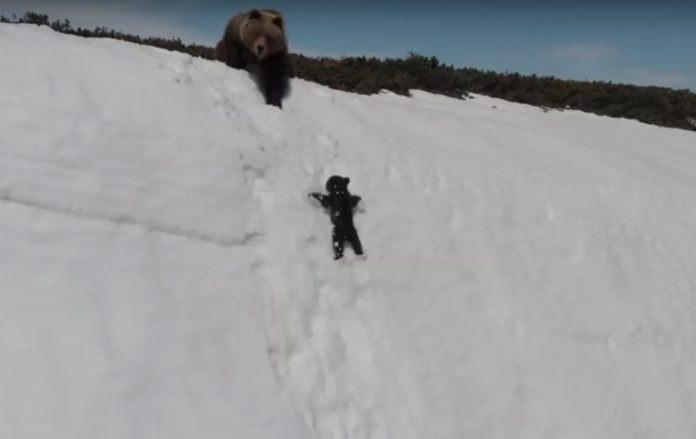In a video that went viral on social media over the weekend, a bear cub struggles up a steep, snow-covered slope towards its mother. The bear climbs a few steps, slips back down, and tries again — over, and over, until it finally reaches the top. To the thousands of people who shared it, it’s an inspirational nature video. To wildlife experts, it’s an irresponsible stunt that endangered the bears.
The post had been making the rounds on Facebook when science communicator Ziya Tong first posted it on Twitter on Saturday.
We could all learn a lesson from this baby bear: Look up & don't give up. pic.twitter.com/nm0McSYeqY
— 𝐙𝐈𝐘𝐀 (@ziyatong) November 3, 2018
Since then, Tong’s post has been retweeted more than 165,000 times. But the video has been met with criticism by wildlife biologists and other experts on Twitter.
Hi Clayton, I agree & sent out this which links to the journal of Current Biology's code of best practice on filming wildlife with drones. Also, two great science writers have been in touch and will be writing articles on the topic. Along with the discussion in the threads…/1
— 𝐙𝐈𝐘𝐀 (@ziyatong) November 5, 2018
To the trained eye, the video shows a frightened mother bear and her cub whose precipitous trek along the ridge may have been prompted by panic. “The bears were extremely disturbed by what definitely appears to me — based on the way it’s moving — a drone capturing a video,” says wildlife ecologist Mark Ditmer, a postdoctoral scientist at Boise State University.
The video has ignited a conversation about responsible drone use around wildlife — and to help drive home the message, Tong shared best-practices for wildlife drone photography. “Without the video going viral people wouldn’t be talking about the topic at all, so it’s an opportunity to educate,” Tong says in a direct message on Twitter.
We don’t know for a fact that the video was filmed by a drone: Tong tracked the video to the YouTube account ViralHog. A representative of ViralHog would only say in an email: “Yes it does appear to be a drone video.” If it is, the clip highlights an ongoing tension between the unprecedented views of wildlife afforded by drones, and the fact that drones can endanger the very animals they’re filming. “It’s a great example of exactly how drones should not be utilized,” Ditmer says.
A few years ago, Ditmer was the lead author of a particularly apropos study that investigated how bears react to drones. The answer? Not well at all. The bears had been outfitted with heart monitors, which let the team watch how their heart rates changed when the bears, say, crossed a road — or when a quadcopter buzzed overhead. Some of the bears started running when a drone flew by, which could put them in danger if they dashed into roads, or through people’s yards. Others didn’t show any visible signs of distress, but their heart rates skyrocketed — a sure sign that the bears were stressed out.
Why would a big, powerful bear be frightened by a little drone? Ditmer suspects that noisy drones that appear out of nowhere spook the bears beneath them. And panic could explain the dangerous route the mother bear and her cub took in that viral video. “I really doubt they would have taken that route, or they would have taken that route much more carefully and slowly, if there weren’t this foreign thing buzzing obviously way too close to them,” he says.
That doesn’t mean that drones are inherently the problem, Ditmer says. “It’s more about responsible use, than about the technology being at fault in any of these cases,” he says. To that end, ecologists Jarrod Hodgson and Lian Pin Koh at the University of Adelaide came up with a set of best practices for scientists flying drones near wildlife. These are described in a paper published in the journal Current Biology in 2016. But for concerned drone operators — and especially people using drones in scientific research — here’s a quick summary:
Be cautious about using a drone near animals if you don’t know how the animals will react. Those reactions are unique to individual species; they’re complex; and they may change over time.
Follow your institution’s ethics guidelines and civil aviation rules.
Use the best equipment you can: that means picking a quiet, unobtrusive drone. And it also means using the most sensitive sensors possible — so you can fly your drone high above the animals.
Launch and recover your drone far away from animals. Fly the drone steadily, and keep it a reasonable distance away from the animals.
Stop flying the drone if you’re bothering the animals.
Report exactly what you did in your publications.
“Really it’s always this tradeoff with how high up and how far away we can be in order to collect the useful information and data that we need,” Ditmer says. For recreational drone users, the calculation is even simpler: follow the rules, and don’t harass the wildlife. So when the choice is between getting a great video of two bears for no apparent scientific purpose or leaving the bears alone, the answer is clear: don’t bother the bears.








